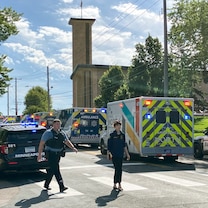NTSB describes turbulence that threw passengers around cabin on Delta flight

A new report states passengers who weren’t buckled aboard a Delta Air Lines flight to Europe were violently thrown into the ceiling and back down to the floor in July when the plane encountered severe turbulence
Passengers who weren't buckled aboard a Delta Air Lines flight to Europe were violently thrown into the ceiling and back down to the floor in July when the plane encountered severe turbulence in a thunderstorm over Wyoming, according to a new report on the incident.
The National Transportation Safety Board said Tuesday that passengers endured 2.5 minutes of turbulence that caught the pilots by surprise on July 30 even though they had already altered their route to try to avoid the storms. The seat belt sign was off so passengers, flight attendants and drink carts were thrown around the plane.
The flight took off from Salt Lake City and was bound for Amsterdam, but it diverted to Minneapolis, where 24 people were evaluated by paramedics and 18 were taken to hospitals. Two crew members sustained serious injuries and five sustained minor injuries.
The preliminary report said during the turbulence the passengers felt a gravitational force up to 1.75 times their body weight.
“That’s a lot of force. That’s like a muscle man grabbing you by the shoulders and with all of his strength trying to pull you up,” said aviation safety consultant Jeff Guzzetti, who used to investigate crashes for the NTSB and FAA. “If you’re standing and you experience those types of forces, you’re going to be thrown upward into the ceiling and then back down again onto the floor with a lot of force.”
Guzzetti said that enduring turbulence that lasted that long would seem like “an eternity” for the passengers feeling those forces. The NTSB also said the plane's wing dipped down as much as 40 degrees at one point, and Guzzetti said that would have alarmed passengers.
That fits with what passengers described afterward.
“They hit the ceiling, and then they fell to the ground,” Leann Clement-Nash told ABC News. “And the carts also hit the ceiling and fell to the ground and people were injured. It happened several times, so it was really scary.”
The report said that the pilot had turned off the seatbelt sign and flight attendants had begun drink service shortly before the plane encountered the turbulence.
The pilots likely believed they were in the clear after asking air traffic controllers to route them around the storms. But the NTSB charted the plane's flight path over a radar report from the National Weather Service that showed the plane flew directly into a bright red section of the map showing the worst of the storm.
Guzzetti said the NTSB will investigate whether the pilots and crew did enough to avoid the storms and whether the pilot made a good judgement in turning off the seatbelt sign.
Serious injuries from in-flight turbulence are rare, but scientists say they may be becoming more common as climate change alters the jet stream.
Several turbulence incidents have been reported this year, which only added to the concerns about aviation safety after the worst aviation disaster in years. In January, a midair collision over Washington, D.C., killed 67 people. A plane also flipped over as it crashed in Toronto in March.
ABC News







